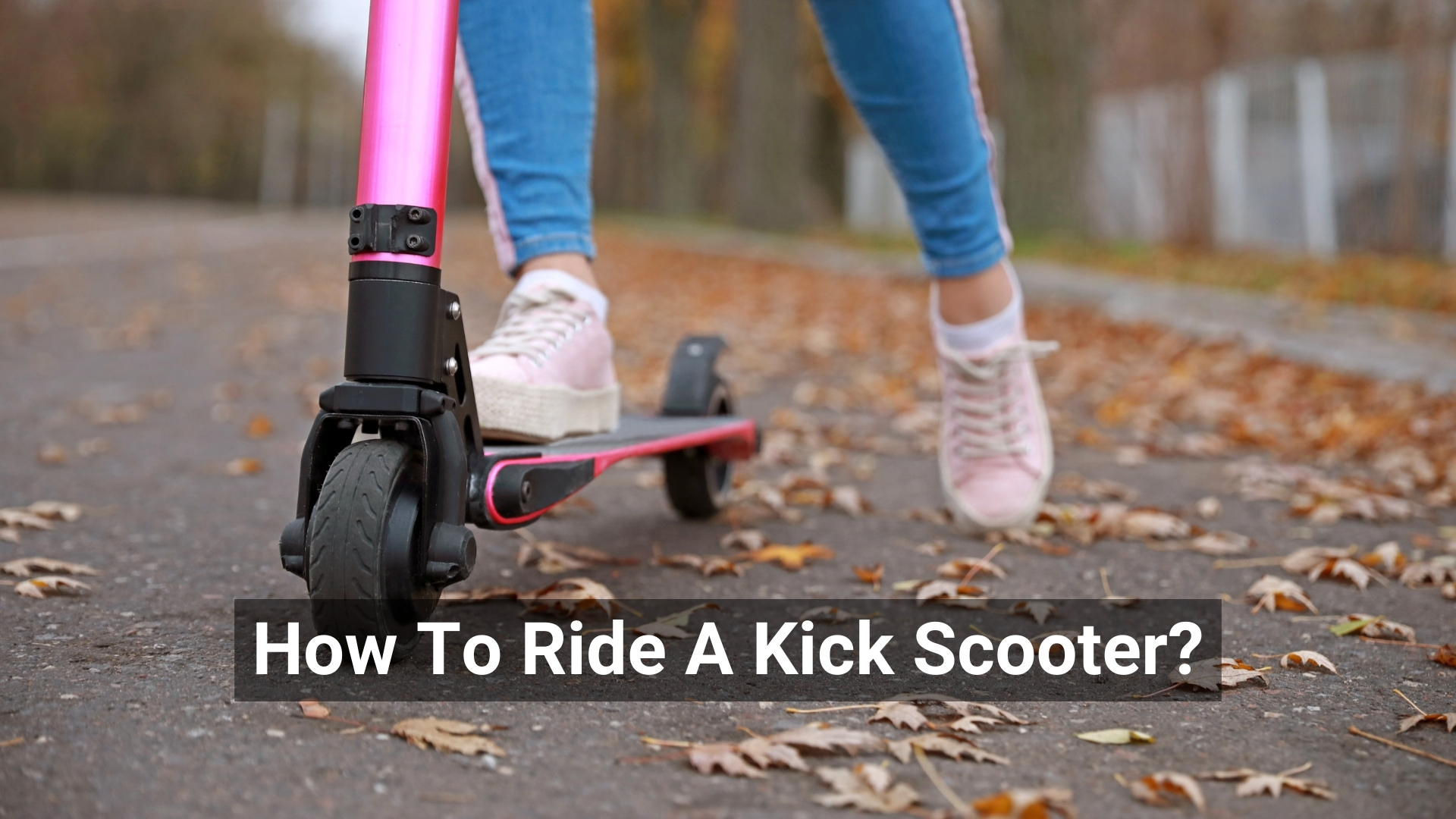Introduction
Hello Champ!
Many people find the idea of riding a kick scooter appealing but may feel unsure of how to get started. This process can seem intimidating to beginners who are concerned about balance, safety, and proper technique.
Learning to ride a kick scooter is easier said than done. With the right guidance and a few basic tips, anyone can master this fun and efficient way of transportation. Understanding the basics of riding, safety practices, and maintenance can change your experience.
In this article, we will provide a step-by-step guide on how to ride a kick scooter, with essential tips and safety tips for beginners. By the end, you will be ready to ride with confidence and enjoy all the benefits that a kick scooter has to offer.
Choosing the Right Kick Scooter
Types of Kick Scooters Suitable for Beginners
For beginners, standard kick scooters are ideal. They are lightweight, easy to maneuver, and generally less complicated than electric or off-road models. Commuter kick scooters are also good for beginners, as they are designed for smooth, urban surfaces and offer comfort and ease of use.
Key Features to Look For
When choosing a kick scooter, look for adjustable handlebars, a sturdy deck, and reliable brakes. The wheels should be of good quality to ensure a smooth ride, and the scooter should be light enough for easy handling but strong enough to support your weight.
Sizing and Adjustments
Proper sizing is crucial for comfort and control. Make sure the handlebars are adjustable to a height that allows you to stand up straight without leaning forward. The deck should be wide enough to accommodate your feet, and the overall size of the scooter should match your height and weight.
Safety First: Essential Gear and Precautions
Wearing a Helmet
Always wear a helmet to protect your head in case of a fall or collision. Choose a helmet that fits comfortably and meets safety standards.
Additional Protective Gear
Consider additional protective gear such as knee and elbow pads, wrist guards and gloves. These can help prevent injuries during falls and boost your confidence while riding.
Inspecting Your Scooter Before Riding
Before each ride, inspect your scooter for damage or loose parts. Check the brakes, make sure the wheels are secure, and make sure the handlebars are tightly fastened.
Preparing to Ride: Getting Started
Finding a Safe Practice Area
Start in a safe, open area free of traffic and obstructions, such as a park or empty parking lot. This allows you to practice without the stress of navigating crowded spaces.
Checking the Scooter’s Condition
Make sure your scooter is in good working order. Check for any loose bolts, check the brakes, and make sure the wheels are properly inflated and spin freely.
Adjusting the Handlebars and Brakes
Set the handlebars to a comfortable height, usually at waist level. Make sure the brakes are easily accessible and responsive to your touch.
How to Ride a Kick Scooter: Step-by-Step Guide
Mounting the Scooter
Positioning Yourself Correctly
Place one foot on the deck and the other on the ground. Stand up straight, distributing your weight evenly.
Gripping the Handlebars
Grip the handlebars firmly with both hands, keeping your elbows slightly bent for better control and comfort.
Pushing Off and Gaining Balance
Using the Dominant Foot
While propelling the scooter forward, use your dominant foot to push off the ground. Once you gain momentum, place your other foot on the deck.
Maintaining Balance
Keep your core engaged and look forward, not down at your feet. Balance your weight evenly and adjust your stance as needed to maintain stability.
Steering and Maneuvering
Turning Techniques
To turn, lean slightly in the direction you want to go while gently steering the handlebars. Practice gentle, wide turns before attempting sharper moves.
Navigating Obstacles
Slow down and navigate around obstacles with ease. Always be aware of your surroundings and plan your route to avoid sudden stops or turns.
Stopping and Braking
Using the Foot Brake
Most kick scooters have a rear foot brake. To stop, press down on the brake with your back foot while maintaining your balance.
Emergency Stops
In an emergency, use both the foot brake and your dominant foot to slow down quickly and safely.
Advanced Riding Techniques
Increasing Speed Safely
Push more often and with more force to increase speed. Always be in control and aware of your surroundings.
Riding on Different Terrains
Smooth Pavement
Riding on smooth pavement is the easiest. Maintain a steady speed and watch for any small obstacles such as pebbles or cracks.
Rough Surfaces
For rough or uneven surfaces, go slower and use a scooter with larger wheels for better stability and shock absorption.
Performing Basic Tricks (Optional)
Once you’re comfortable, you can try basic tricks like bunny hops or wheelies. Always exercise in a safe place and wear proper gear to avoid injury.
Riding Etiquette and Best Practices
Sharing the Path with Others
Be considerate of others using the road. Slow down when passing pedestrians and use a bell or verbal signal to alert them.
Obeying Traffic Rules
Obey all traffic laws, including stopping at signs and signals. Ride in designated areas and watch out for other vehicles.
Respecting Pedestrians
Yield to pedestrians and give them the right of way. Avoid riding on crowded sidewalks and always be polite.
Common Mistakes and How to Avoid Them
Overcoming Balance Issues
If you struggle with balance, practice riding slowly and using a wider stance. Focus on keeping your core engaged and your eyes forward.
Avoiding Abrupt Stops
A sudden stop can cause a fall. Practice braking gradually and learn to anticipate stopping by observing your surroundings.
Navigating Tight Turns
Take tight turns slowly and gently lean into the turn. Practice makes perfect, so start with wider turns and gradually tighten your radius.
Maintaining Your Kick Scooter
Regular Maintenance Tips
Regularly check for loose bolts, clean bearings, and lubricate moving parts. Keep the wheels in good condition and make sure the brakes are working properly.
Troubleshooting Common Issues
Address any unusual noises, steering problems, or braking problems immediately. Regular maintenance helps prevent these problems from becoming serious.
When to Seek Professional Help
If you are facing major problems or are not sure how to solve a problem, seek professional help. A technician can ensure your scooter stays safe and functional.
Conclusion
Learning to ride a kick scooter is a fun and accessible skill that anyone can master. This guide covers the essential steps from choosing the right scooter to understanding safety equipment and mastering basic riding techniques. We discussed the latest riding practices, etiquette, and common mistakes to avoid to ensure a safe and fun experience. Regular maintenance keeps your scooter in top condition, increasing your riding enjoyment.
For more information on kick scooters and other sports-related topics, explore our website—your one-stop destination for the latest trends, tips, and expert advice.
FAQs
Q1. Is riding a kick scooter hard?
Riding a kick scooter is easy to learn with practice. Most people get the hang of it within a few hours to a few days, making it a fun and accessible activity for all ages.
Q2. What should I wear when riding a kick scooter?
Always wear a helmet, and consider additional protective gear such as knee and elbow pads. Comfortable clothing and closed-toe shoes with good grip are also recommended for safe riding.
Q3. How do I maintain balance on a kick scooter?
Keep your core engaged, look forward, and distribute your weight evenly. Practice riding slowly to build confidence and improve balance.
Q4. Can kids and adults use the same riding techniques?
Yes, basic riding techniques are the same for children and adults. However, children should use age-appropriate scooters and be supervised by an adult.
Q5. How often should I check my kick scooter for maintenance?
Inspect your kick scooter before each ride. Regularly check for loose bolts, ensure brake function, and keep wheels in good condition to ensure safe riding.











